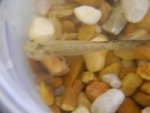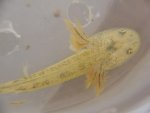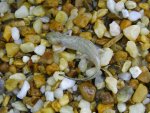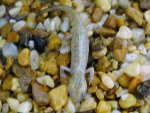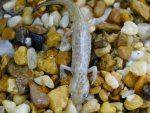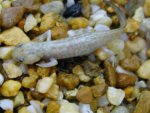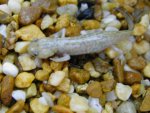-
Did you know that registered users see fewer ads? Register today!
You are using an out of date browser. It may not display this or other websites correctly.
You should upgrade or use an alternative browser.
You should upgrade or use an alternative browser.
Leucistic Tiger?
- Thread starter pseudobranchus
- Start date
oceanblue
New member
This looks leucistic to me. If there are any yellow or shiny reflective pigment spots around it is not axanthic. It will be interesting to see what it grows up to be.
I see quite a bit of dark flecking on the body, so I'm doubting that it's leucistic. I would suggest hypomelanistic as a possibility. But it's probably too soon to tell. Please post another photo in a few weeks, it will be interesting to see it as it grows.
callina
New member
- Joined
- Sep 16, 2007
- Messages
- 622
- Reaction score
- 32
- Points
- 0
- Age
- 66
- Location
- Oldenburg (North Sea)
- Country
- Germany
- Display Name
- Tina
oh, that´s very interesting. I´ve never seen a leucistic tiger before.
I´ve never seen a leucistic tiger before.
Thanks for the pic
Tina
Thanks for the pic
Tina
pseudobranchus
New member
Thanks for the responses, as it grows i'll keep you guys updated. Thanks
Nathan
Nathan
pseudobranchus
New member
pseudobranchus
New member
One of the tiger larvae i found just finished morphing here is a few pics, i'll take some better ones in a week or i just don't want to disturb it too much.
Nathan
Nathan
Attachments
pseudobranchus
New member
I actually have a total of 8 that will be morphing out. The one in the pics above had the most black of all of them, and when it morphed it lost a lot of black, the dark pigment save for on the tail is actually a purplish coloration, the others have much more yellow so i'm expecting once they morph out they will be much nicer.
Nathan
Nathan
electronfusion
New member
- Joined
- Sep 17, 2009
- Messages
- 54
- Reaction score
- 1
- Points
- 0
- Country
- United States
Wow. I had assumed only axolotls had these types of freak color mutations. That translucent light gray is so pretty.
thewesterngate
New member
- Joined
- Mar 26, 2010
- Messages
- 24
- Reaction score
- 2
- Points
- 0
- Age
- 36
- Location
- Greenville, NC
- Country
- United States
- Display Name
- Brie
I agree, this is fascinating. It would be awesome if you could isolate the gene and get them to reproduce.  I'd certainly love one.
I'd certainly love one.
Azhael
Site Contributor
- Joined
- May 7, 2007
- Messages
- 6,644
- Reaction score
- 121
- Points
- 0
- Location
- Burgos
- Country
- Spain
- Display Name
- Rodrigo
Fascinating...but i certainly hope you refrain from making a profit of the aberrants. They are VERY unlikely to breed, but i hope you won´t even try. It´s bad enough that axolotls have been diluted and heavily selected...it would be sad to see tigers going the same way.
I for one, hope you DON´T breed or isolate anything....
I for one, hope you DON´T breed or isolate anything....
Fascinating, i am looking forward to how the colors, in combination with the tigermarking, will look like!:happy:
Azhael, I think it wont hurt to be a little more easy going on this matter.
What will it hurt of there is a bloodline of aberrant tigers, it doenst mean all tigers (especially since they are so hard to breed) will be poluted with inbreeding.
Sometimes its nicer and more fun to just share enthousiasm instead of critisism and moral!
P.s: don't intend to start an offtopic discussion
Azhael, I think it wont hurt to be a little more easy going on this matter.
What will it hurt of there is a bloodline of aberrant tigers, it doenst mean all tigers (especially since they are so hard to breed) will be poluted with inbreeding.
Sometimes its nicer and more fun to just share enthousiasm instead of critisism and moral!
P.s: don't intend to start an offtopic discussion
Azhael
Site Contributor
- Joined
- May 7, 2007
- Messages
- 6,644
- Reaction score
- 121
- Points
- 0
- Location
- Burgos
- Country
- Spain
- Display Name
- Rodrigo
Oh, i know my opinion is rather radical, but it´s based on the observation on how the very moment when an aberrant appears, it´s selected and bred to obtain more and more aberrants. One bloodline of aberrants is definitely not the end of the world....but it never stops there. They will be selected for their weird coloration, and more people will want the "cool looking morph". After a few years you have large numbers of aberrants. I just see what has happeend with axolotls, ball pythons, cornsnakes, many species of gecko, pogonas...etc...
There is a true morph craze .
Those all started as an innocent isolated case..and now they might even outnumber the wild types in captivity.
I wasn´t critizicing, really, i was merely expressing my point of view on the matter...and what can i say..i really do hope this doesn´t extend further.
There is a true morph craze .
Those all started as an innocent isolated case..and now they might even outnumber the wild types in captivity.
I wasn´t critizicing, really, i was merely expressing my point of view on the matter...and what can i say..i really do hope this doesn´t extend further.
Coastal Groovin
Active member
Very few people have cb tiger salamanders almost all are pond raised which I don't count as cb. It is very unlikely they will ever be bred to pass down those genes.
I think that fact makes them not worth much more than a normal more colorful animals that are seen for sale all the time. Just my opinion though. I wouldn't pay more that 50 bucks. High yellow animals or almost black animals are much for interesting to me.
I think that fact makes them not worth much more than a normal more colorful animals that are seen for sale all the time. Just my opinion though. I wouldn't pay more that 50 bucks. High yellow animals or almost black animals are much for interesting to me.
electronfusion
New member
- Joined
- Sep 17, 2009
- Messages
- 54
- Reaction score
- 1
- Points
- 0
- Country
- United States
It´s bad enough that axolotls have been diluted and heavily selected...it would be sad to see tigers going the same way.
I for one, hope you DON´T breed or isolate anything....
Hmm, I understand the sentiment against inbreeding to produce something pretty. And I can't say I really know how much this has or has not happened in axolotls. But to me it is quite conceivable that a specific gene could be spread very far and wide without ever having to resort to sketchy breeding practices.
If pseudobranchus' batch of tigers all inherited this mutation inadvertently, then it's very possible that the coloration is due to a dominant (rather than recessive) gene, in which case possibly one of the parents has the gene but just didn't express for some reason. This would mean that each of these offspring could be bred with outside lines of tigers and their offspring would all have the gene, and probably most of them express it.
Another possibility is that the gene is recessive, in which case you could still breed them all out with other lines of tigers, and then breed those offspring out with other lines of tigers, and then breed some of those 2nd (or better yet, 3rd or 4th) cousins together, to get offspring with 2 copies of the gene. Then of course, start the process over, out-breeding those in the new generation of heterozygotes several times over. This would make for an extremely slow start,and require a very large-scale operation, either in a huge facility, or in cooperation between a few dedicated individuals. Butit would be enough to establish a new line of light colored tigers without compromising health or genetic diversity.
After all, I don't know about in animals, but in human history, inbreeding has only become a problem when extremely concentrated groups inbred for long periods, like with the Hawaiian Monarchy, where brothers and sisters bred together for one generation after another, until there were serious mental health issues.
Charles Darwin's family was somewhat inbred, but he was smart enough to single-handedly discover that inbreeding was bad in plants, and healthy enough to have lived a full, healthy life for that time. His children (although he worried about them because of his research findings) also were healthy.
Again, not advocating inbreeding here, but selective breeding for attractive traits is definitely alright, and can be done properly.
Azhael
Site Contributor
- Joined
- May 7, 2007
- Messages
- 6,644
- Reaction score
- 121
- Points
- 0
- Location
- Burgos
- Country
- Spain
- Display Name
- Rodrigo
selective breeding for attractive traits is definitely alright[/B], and can be done properly.
That´s exactly what i don´t agree with.
I fully understand the atractiveness of certain morphs, but deforming the species and selecting aberrants is definitely not ok in my book.
I´ll never understand why people can´t just enjoy the wonderfulness of each species as it is, naturally.
deliriah
New member
- Joined
- May 25, 2008
- Messages
- 236
- Reaction score
- 1
- Points
- 0
- Location
- Massachussetts
- Country
- United States
I have to agree with Azhael. By selective breeding, we tend to lose appreciation for the beauty of the original animal.
im just gonna give my 2 cents on this matter, i for one feel that selective breeding can be used to produce stronger more readily available specimens, add in a neat color morph and you could even breed your own species in a few decades, the idea of genetic purity is a little weird to me, i can fully understand how inbreeding spreads genetic pollution but if it is done correctly and the stocks are supplemented with enough new genetic material then there should be no issues with pollution.
axies (if im not mistaken) can't be natural supplemented with wild specimens as they are endangered, this is probably why there isn't as much pollution in geckos, cornsnakes, pythons, etc as there is in axies, now that tigers are being bred in captivity more and more the chances of "designer" pets increases, i love bettas and the wide variety that they are found in is directly because of selective breeding, a natural male has much shorter less colorful fins and reduced aggression, if the same were to happen to tigers (sans aggression) it would be marvelous.
imagine a tiger with an extended tail or one with a hardier, thicker skin to help it fight off fungus and disease, a super tiger if you will.
axies (if im not mistaken) can't be natural supplemented with wild specimens as they are endangered, this is probably why there isn't as much pollution in geckos, cornsnakes, pythons, etc as there is in axies, now that tigers are being bred in captivity more and more the chances of "designer" pets increases, i love bettas and the wide variety that they are found in is directly because of selective breeding, a natural male has much shorter less colorful fins and reduced aggression, if the same were to happen to tigers (sans aggression) it would be marvelous.
imagine a tiger with an extended tail or one with a hardier, thicker skin to help it fight off fungus and disease, a super tiger if you will.
AaronK
2010 Research Grant Donor
- Joined
- May 7, 2007
- Messages
- 142
- Reaction score
- 12
- Points
- 18
- Location
- California
- Country
- United States
- Display Name
- AaronK
imagine a tiger with an extended tail or one with a hardier, thicker skin to help it fight off fungus and disease, a super tiger if you will.
oh my...
General chit-chat
- No one is chatting at the moment.

